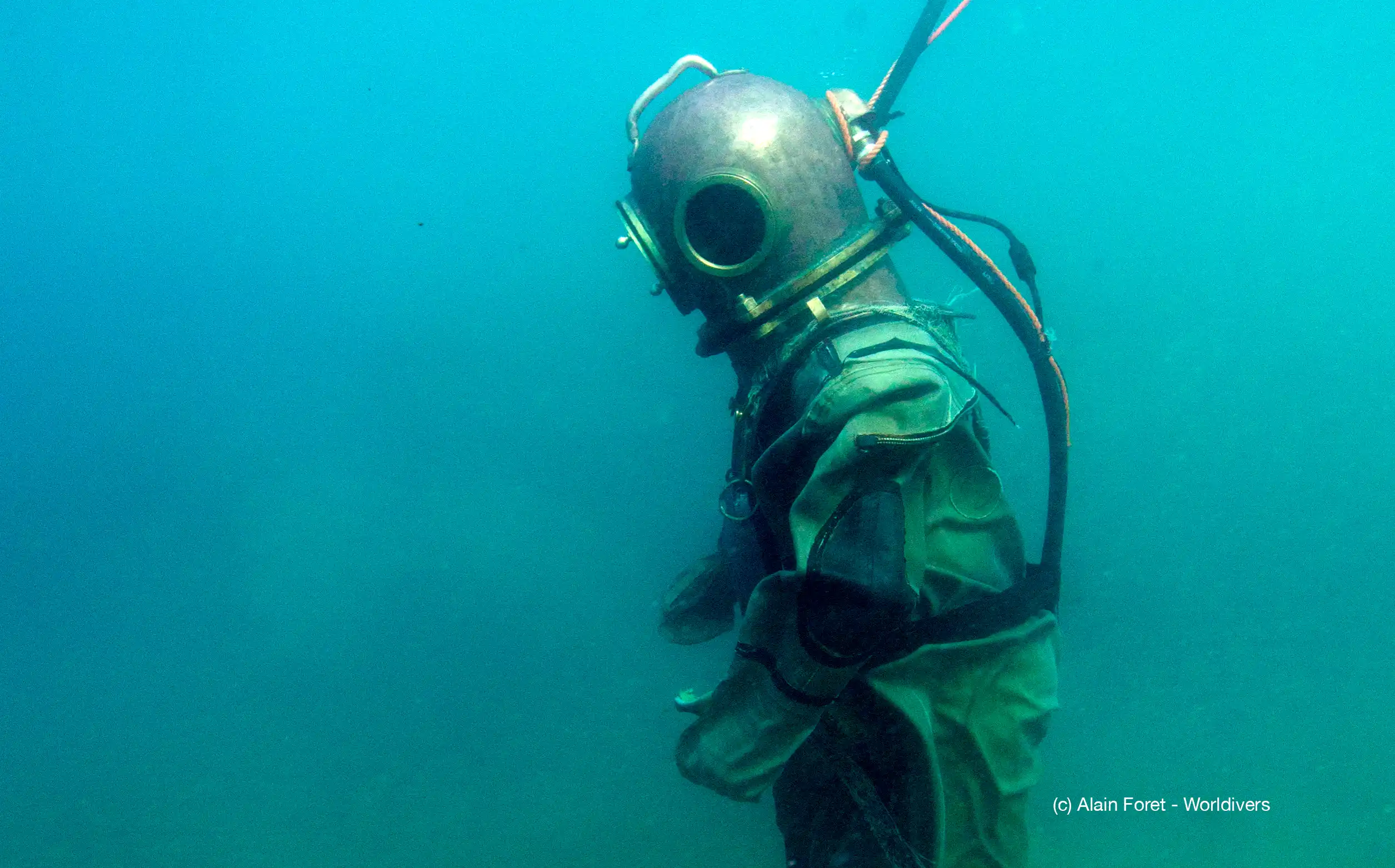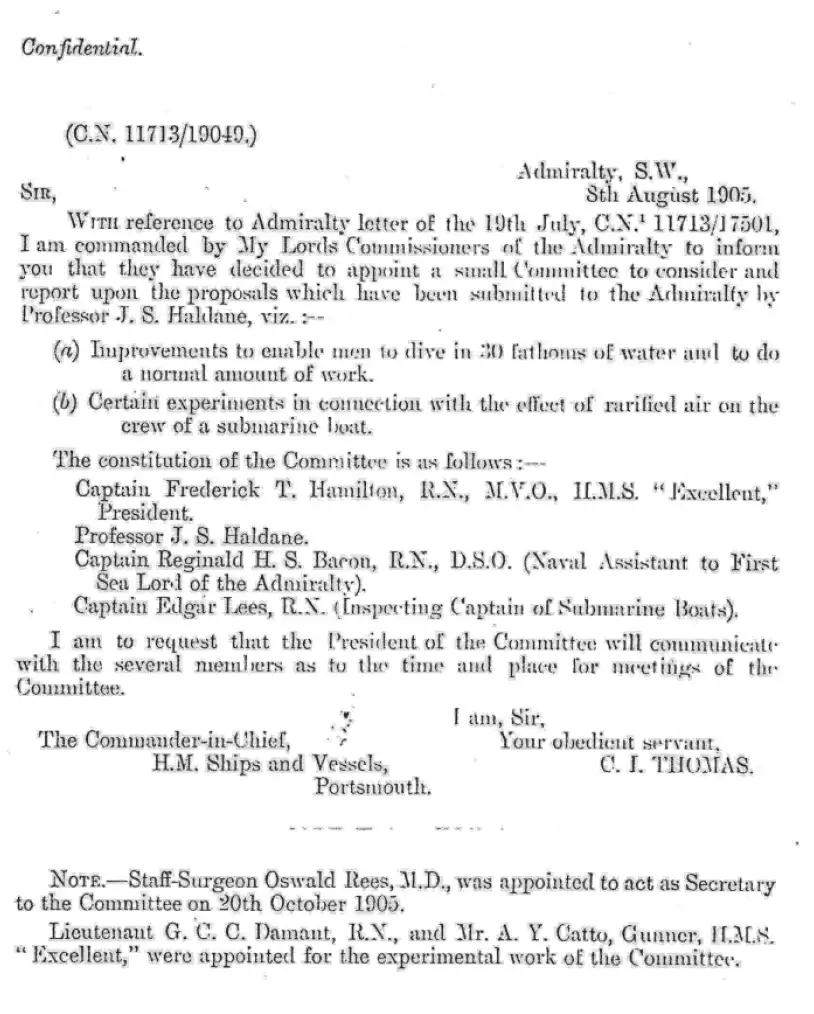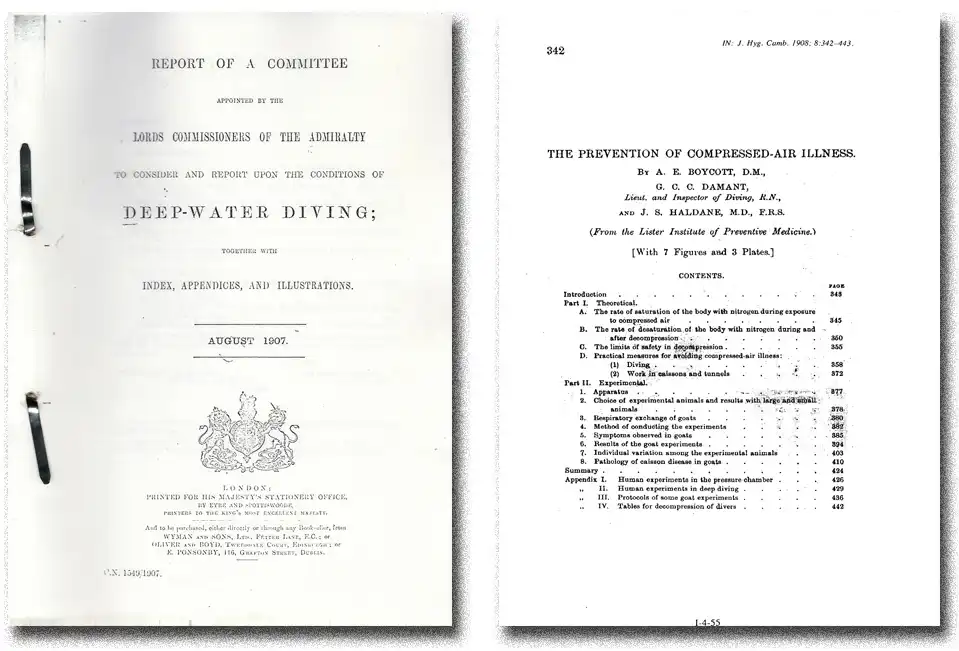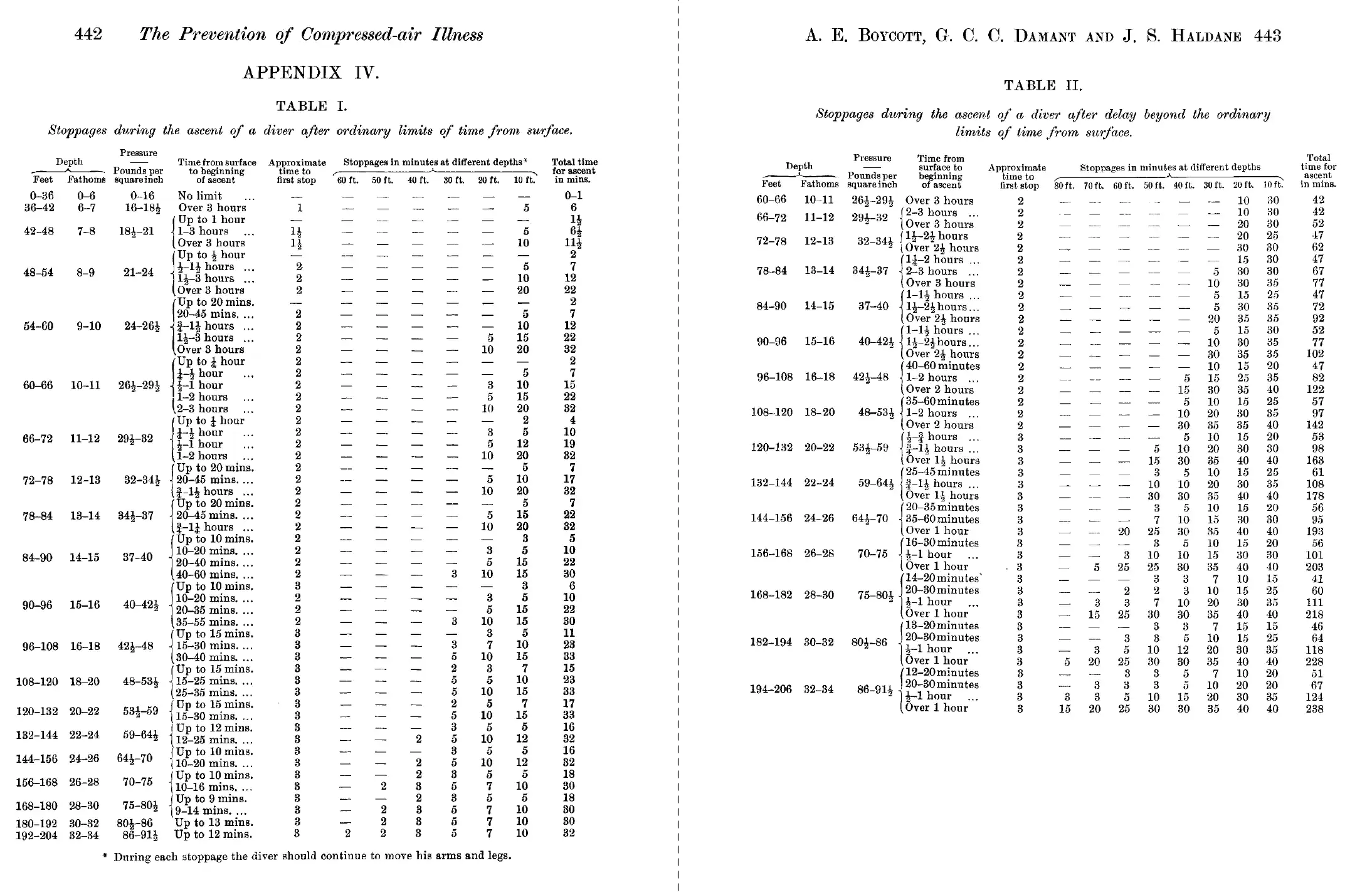Haldane 1908
Ref. 25-027/CMAS/TC - 18 August 2025

By Alain Foret, French translator of the 1908 publication by Haldane et al.
Haldane J.-S. et coll., The prevention of decompression air Illness, J. Hyg., 1908, pp. 342-443.
Translated into French in 2008, with the permission of Cambridge University Press, Foret A., Prévention de la maladie de décompression, Téthys, 2008.
Introduction
The 1908 publication established the first decompression model and the first diving tables, creating the concept of decompression stops based on the maximum depth reached and the dive time (which at the time was opposed to a slow and uniform ascent, independent of depth and dive time).
When did the Royal Navy submit its request?
The letter from the British Admiralty asking Haldane to work on the subject of decompression is dated 8 August 1905.
It is reproduced here (document collection A. Foret).
It is reproduced here (document collection A. Foret).

When were Haldane's tables published: 1907 or 1908?
The (confidential) report to the Admiralty dates from August 1907. The first official publication, accessible to all, dates from 1908 in the Journal of Hygiene [1].
Therefore, the date chosen is 1908, as 1907 refers to a confidential document (documents from the A. Foret collection).
Therefore, the date chosen is 1908, as 1907 refers to a confidential document (documents from the A. Foret collection).

Haldane tables, what is the maximum depth?
Two tables have been published:
This 60 m limit was not imposed on Haldane by narcosis but by the power limit of the pumps supplying the divers and by the Royal Navy's 1905 mission statement ("(a) Improvements to enable men to dive in 30 fathoms of water ... " – 30 fathoms = 55 m, he went down to 34 ftm = 62 m).
- one for dives of ‘normal’ duration [maximum total ascent time: 33 min.];
- the other for dives ‘beyond normal duration’ [total ascent time: 42 to 238 min.].
This 60 m limit was not imposed on Haldane by narcosis but by the power limit of the pumps supplying the divers and by the Royal Navy's 1905 mission statement ("(a) Improvements to enable men to dive in 30 fathoms of water ... " – 30 fathoms = 55 m, he went down to 34 ftm = 62 m).
Table at 100 m? A mistake in a publication.
H. V. HEMPLEMAN in The Physician’s Guide To Diving Medicine, Plenum Press, New York, 1984 writes on page 237 that Haldane published three different tables, including one for deep dives to a depth of 100 m: “Haldane issued three separate air diving tables. The first table was for all those dives requiring a decompression time of less than 30 minutes. The second table was for all air dives requiring a decompression time of more than 30 min. and the third table was for deep air to depths of 330 ft (100 m). " We would then expect these three tables to be published on the following pages. However, the author only publishes two, on pages 239 and 240, which are the Haldane tables we are familiar with. And for good reason: Haldane never published tables for 100 m.Haldane's 10 hypotheses
Here are the 10 hypotheses selected by Haldane, with references to the corresponding page numbers in the original 1908 publication in The Journal of Hygiene [1].
- In the lungs, excess nitrogen is instantly transferred to the blood (p. 345).
- In the lungs, during decompression, with each circulatory cycle, the blood instantly transfers the excess nitrogen it contains to the lungs (p. 351).
- In the tissues, excess nitrogen is transferred instantly (p. 345).
- The partial pressure of nitrogen in the alveolar air is the same as in the inhaled air (p. 345).
- All tissues have a similar composition to blood, except for fat, which it treats differently (p. 346).
- A circulatory cycle takes place in 1 minute (p. 348).
- The desaturation curve mirrors the saturation curve (p. 350).
- The Critical supersaturation (Cs) must not exceed 2:1 (p. 357). This would correspond today to setting a Cs=2 [or, under certain conditions, 1.58 when considering only nitrogen, with a proportion of 0.79 (0.79 x 2 = 1.58)]. Haldane sets a single Cs for all compartments.
- The phenomena of nitrogen loading and unloading in the human body can be summarised in five compartments (fictitious anatomical regions) whose half-times are: 5, 10, 20, 40 and 75 minutes (p. 363).
- The descent time is included in the dive time (p. 367). The virtual exposure time considered is the actual bottom exposure time, increased by half the descent time (p. 350).
Other contributions by Haldane
Beyond the creation of stop decompression, Haldane makes a number of interesting observations throughout the publication:
- He recommends moving the arms and legs during stops to prevent the conditions of desaturation from being very different from those of saturation (p. 367);
- Age and excess weight appear to increase the risk of accidents (p. 368);
- The ascent rate of around 10 m/min is determined empirically (p. 370);
- He discusses the concept of factors specific to each individual and variables that can vary from one day to the next and may contradict the decompression model [today we refer to these as individual risks factors] (p. 384).
- He notes the presence of bubbles without symptoms (p. 411) [today we refer to these as ‘silent bubbles’].
Haldane's model and Haldanian sets of parameters
Haldane's model is characterised by:
VPM [3] and RGBM [2] also use a Haldanian set of parameters.
- Parallel compartments, characterised by their half-times;
- A tolerance limit for each ascent, either in the form of Critical supersaturation (Cs) or M-values (contribution by Workman, 1965, by transforming the Cs equation into M-values).
- The one used to calculate the level of neutral gas (nitrogen, helium) in each compartment: Haldane's equation (fixed depth) modified by Schreiner to incorporate variable depth during a time segment (dive computers);
- The one that dictates the conditions for ascent (Cs or M-Values - including GF, which are only M-Value reduction factors - find out more).
- U.S. Navy and variants (RDP PADI, PDIC, Huggings, Bassett, etc.);
- Bühlmann;
- Hahn;
- Comex;
- French Navy (MN90, French Navy 2023);
- ...
VPM [3] and RGBM [2] also use a Haldanian set of parameters.
Haldane's Tables, 1908

Références :
[1] Haldane J.-S. et coll., The prevention of decompression air Illness, J. Hyg., 1908, pp. 342-443.
[2] Bruce R. Wienke, Reduced Gradient Bubble Model in Depth, Best Publishing Company, 2003, p. 34 (use of Bühlmann compartments).
[3] Yount D.E., Varying Permeability Model. As indicated in the programme source code, VPM uses the ZH-L16C set of parameters.
PROGRAM VPMDECO
C===============================================================================
C Varying Permeability Model (VPM) Decompression Program in FORTRAN
C Author: Erik C. Baker
C "DISTRIBUTE FREELY - CREDIT THE AUTHORS"
C This program extends the 1986 VPM algorithm (Yount & Hoffman) to include
C mixed gas, repetitive, and altitude diving. Developments to the algorithm
C were made by David E. Yount, Eric B. Maiken, and Erik C. Baker over a
C period from 1999 to 2001. This work is dedicated in remembrance of
C Professor David E. Yount who passed away on April 27, 2000.
C Notes:
C 1. This program uses the sixteen (16) half-time compartments of the
C Buhlmann ZH-L16 model. The optional Compartment 1b is used here with
C half-times of 1.88 minutes for helium and 5.0 minutes for nitrogen.
[4] Foret A., Plongée Plaisir 4, Éditions GAP, 12e édition, 2025.









